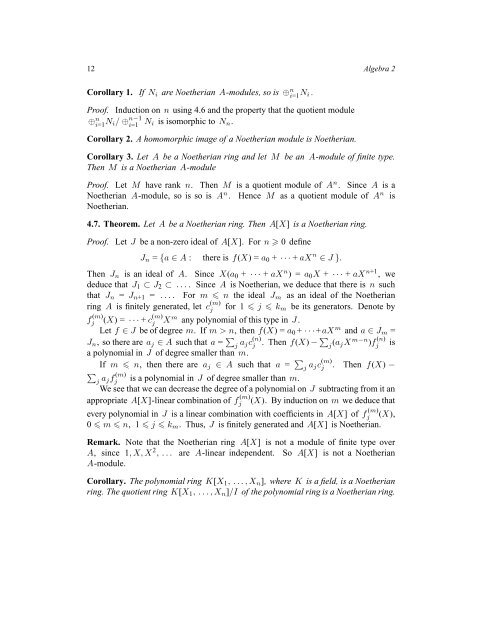Algebra (Unknown 27). - Index of
Algebra (Unknown 27). - Index of
Algebra (Unknown 27). - Index of
You also want an ePaper? Increase the reach of your titles
YUMPU automatically turns print PDFs into web optimized ePapers that Google loves.
12 <strong>Algebra</strong> 2<br />
Corollary 1. If N i are Noetherian A-modules, so is ⊕ n i=1 N i .<br />
Pro<strong>of</strong>. Induction on n using 4.6 and the property that the quotient module<br />
⊕ n i=1 N i/ ⊕ n−1<br />
i=1 N i is isomorphic to N n .<br />
Corollary 2. A homomorphic image <strong>of</strong> a Noetherian module is Noetherian.<br />
Corollary 3. Let A be a Noetherian ring and let M be an A-module <strong>of</strong> finite type.<br />
Then M is a Noetherian A-module<br />
Pro<strong>of</strong>. Let M have rank n. Then M is a quotient module <strong>of</strong> A n . Since A is a<br />
Noetherian A-module, so is so is A n . Hence M as a quotient module <strong>of</strong> A n is<br />
Noetherian.<br />
4.7. Theorem. Let A be a Noetherian ring. Then A[X] is a Noetherian ring.<br />
Pro<strong>of</strong>. Let J be a non-zero ideal <strong>of</strong> A[X]. For n 0 define<br />
J n = {a ∈ A : there is f(X) = a 0 + · · · + aX n ∈ J }.<br />
Then J n is an ideal <strong>of</strong> A. Since X(a 0 + · · · + aX n ) = a 0 X + · · · + aX n+1 , we<br />
deduce that J 1 ⊂ J 2 ⊂ . . . . Since A is Noetherian, we deduce that there is n such<br />
that J n = J n+1 = . . . . For m n the ideal J m as an ideal <strong>of</strong> the Noetherian<br />
ring A is finitely generated, let c (m)<br />
j<br />
(X) = · · · + c (m)<br />
f (m)<br />
j<br />
for 1 j k m be its generators. Denote by<br />
j<br />
X m any polynomial <strong>of</strong> this type in J .<br />
Let f ∈ J be <strong>of</strong> degree m. If m > n, then f(X) = a 0 + · · · +aX m and a ∈ J m =<br />
J n , so there are a j ∈ A such that a = ∑ j a jc (n)<br />
j<br />
. Then f(X) − ∑ j (a jX m−n )f (n)<br />
j<br />
is<br />
a polynomial in J <strong>of</strong> degree smaller than m.<br />
If m n, then there are a j<br />
∈ A such that a = ∑ j a jc (m)<br />
j . Then f(X) −<br />
∑j a jf (m)<br />
j<br />
is a polynomial in J <strong>of</strong> degree smaller than m.<br />
We see that we can decrease the degree <strong>of</strong> a polynomial on J subtracting from it an<br />
appropriate A[X]-linear combination <strong>of</strong> f (m)<br />
j<br />
(X). By induction on m we deduce that<br />
every polynomial in J is a linear combination with coefficients in A[X] <strong>of</strong> f (m)<br />
j (X),<br />
0 m n, 1 j k m . Thus, J is finitely generated and A[X] is Noetherian.<br />
Remark. Note that the Noetherian ring A[X] is not a module <strong>of</strong> finite type over<br />
A, since 1, X, X 2 , . . . are A-linear independent. So A[X] is not a Noetherian<br />
A-module.<br />
Corollary. The polynomial ring K[X 1 , . . . , X n ], where K is a field, is a Noetherian<br />
ring. The quotient ring K[X 1 , . . . , X n ]/I <strong>of</strong> the polynomial ring is a Noetherian ring.

















